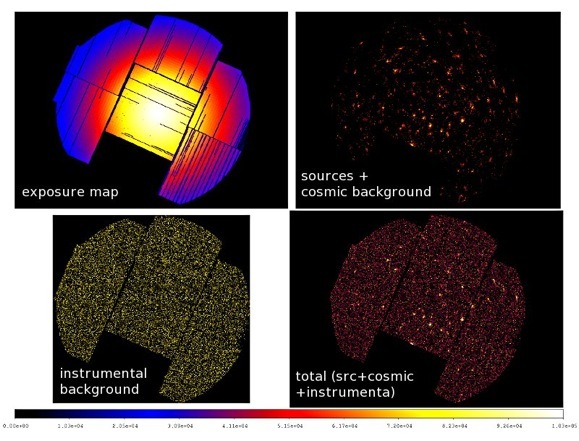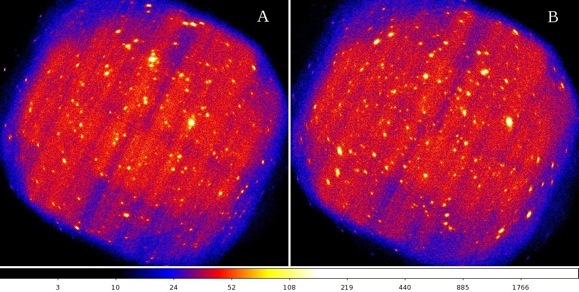The XMM-CDFS simulator
This is a general purpose, multi-mission X-ray simulator. It has been written to produce simulations of the XMM survey in the Chandra Deep Field South (the deepest XMM pointing made to date, consisting of 33 individual observations centred on the CDFS), which are needed to test the accuracy and completeness of the souce catalogue.
The simulator has also been written with the mission project formerly known as XEUS/IXO/Athena in mind, so that it can readily be updated to other missions (e.g., Chandra). The only assumptions are that a library of position-dependent PSFs is available, that the effective area of the telescope and detector is known, and that an exposure map is provided to account for vignetting and eventual chip gaps. A background map can be used to account for the instrumental component.
Features:
- produces event files, to be analyzed with common X-ray data analysis software;
- supports an arbitrary number of sources;
- arbitrary spectra can be assigned to the sources;
- calculates the most appropriate PSF for each source, according to position and energy, by interpolating from the PSF library;
- reproduces the correct balance of background components (cosmic, particle and residual soft protons).
The simulator at work:
The following is a simulation of a 100ks exposure with the MOS1 in the 2-10 keV band in a field without bright sources, like the CDFS. The exposure map is a real one from the XMM-CDFS survey, while fluxes of the sources are randomly drawn from the sum of the Gilli et al. (2007) AGN LogN-LogS and of the Ranalli et al. (2005) galaxies one. Sources with fluxes down to 10-20 erg/s/cm2 have been included in order to reproduce the cosmic X-ray background. The positions are randomly drawn according to a uniform distribution.
Since the simulator models separately the sources and the instrumental background, hereafter I show both the “cosmic” and the instrumental (particle) part of the simulation separately, and finally the sum of both components.

The following is a simulation of the whole 33-pointings XMM-CDFS survey, compared to the real observation. The first results are described in Comastri et al. (2011, A&A 526, L9), while the details of the observations are found in Ranalli et al. (2013, A&A 555, A42). The background model is also fully described in the Ranalli et al. paper.
Briefly, the XMM-CDFS consistes of 8 observations dating from the years 2001-2002, and 25 observations done in the period 2008-2010, for a total exposure of 3.3 Ms. There are shifts of a few arcminutes between observations performed in summer vs. winter. Small shifts of the order of 10 arcsec in different directions have been used in the pointing to smooth the CCD gaps and bad columns.

(the real XMM-CDFS is on the left, the simulation on the right)
To reproduce the spatial distribution of the background as closely as possible, the simulator considers the following components:
- cosmic X-ray background;
- particle background;
- residual, quiescent soft proton component.
The solar wind charge-exchange (SWIX) is not considered, since the XMM-CDFS is essentialy a hard X-ray survey, and the SWIX is negligible at energies >1 keV.
Each of the above components has its own spatial distribution. The cosmic X-ray background, being the product of many unresolved sources, follows the mirror vignetting. The particle background is not vignetted, but has its own areas of higher and lower brightness which depend on the chip position. The residual soft proton (which cannot be excluded with light curve cleaning, since they are a quiscent component) are also vignetted, though to a lesser extent than X-ray sources. The details can be found in Kuntz & Snowden (2008, A&A 478, 575).
The balance among the three components varies, and should be tuned to each observation for best results. The simulator includes an analyzer tool which determines the balance by measuring the background brightness inside and outside of the field of view (the XMM-Newton EPIC camera has unexposed corners, where the particle background can be measured), and comparing the inside/outside ratio with Filter Wheel Closed observations.
The simulator is written in the Perl programming language, making use of the Perl Data Language (PDL) libraries for numerical computation and FITS input/output. The Ftools package is used to process the simulated event file headers and make it readable by the SAS; the SAS tool merge is used to join the source and background event files.
This simulator is free software. Its first release includes the source+CXB part, and is available here and on github under the terms of the Affero General Public License (AGPL). Next releases will include also the particle and proton simulators. Instructions for installation are included in the release (basically, a working Ftools+XMMSAS+PDL environment is needed).
Contact:
Piero Ranalli
IAASARS, National Observatory of Athens
Metaxa & Pavlou, 15236 Penteli, Athens
Greece
pranalli.github@gmail.com
Last update: 2015/12/4.